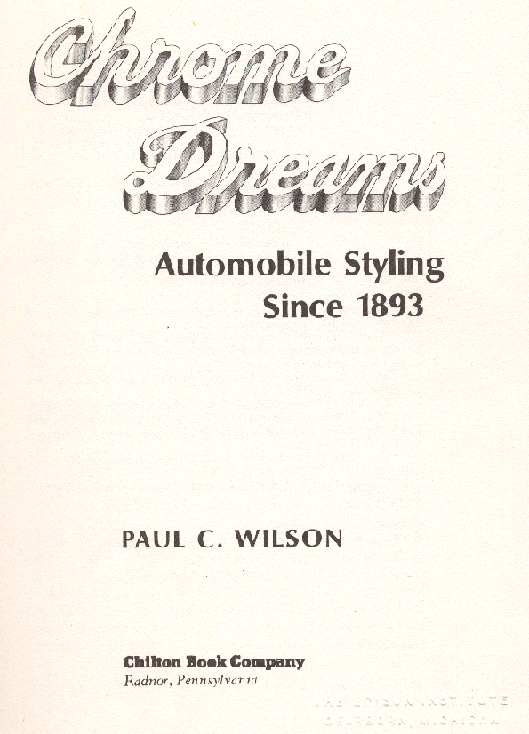Chrome Dreams: Automobile Styling Since 1893

(Excerpt from Preface of Chrome Dreams)
When archaeologists thousands of years from now dig into the stratum containing
implements from our time, chances are that their shovels will clang against
the rusted fender of an automobile. They will dig it up, clean it off, and
when they discover its importance in twentieth century life, they will interpret
it as we interpret clay pottery and fragments of statues--as an icon expressive
of the culture which produced it. The automobile will not be inappropriate
for their purpose. While these future archaeologists will also unearth our
buildings, some sculpture, and perhaps a few paintings, these will only reflect
the tastes of the individuals or small groups that produced them; the automobile,
by contrast, is much closer to being a collective creation of the culture.
Strictly speaking, of course, the appearance of an automobile is determined by its designers, who in turn are influenced by considerations of practicality. But the power of veto exerted by the public by simply refusing to buy an unattractive car is so great that public taste must be counted as the most important single influence on style evolution. A sculptor need only please himself, an architect need only satisfy a committee or a client, but a stylist must often appeal to a million people with a single design. And the appeal must be so strong that the buyer will make the large investment needed to buy a car. As a result, I think it is valid to consider the automobile an object of popular art, and to interpret its appearance as an expression of the culture and period which produced it. What better symbol of the late 1920s, for example, could be found than the original Cadillac V16, which was designed in the late '20s and introduced in 1930? No design of the early '20s or mid '30s celebrates raw wealth with such uninhibited joy; different periods speak visually in different tones.
The assumption on which this book has been written is that the automobile is a "meaningful form" in our culture and deserves serious study. Such a study might move from automobile style in an almost infinite number of directions, however, and to confine the present book within reasonable bounds I have given scant treatment to many subjects that are related to the development of style. This is not an account of the competitive struggles between the automobile manufacturers; not a balanced history of the evolution of the automobile, which would have to include far more information on mechanical development; not a story of the personalities and decisions that contributed to advances in design. Here and there, these peripheral matters are touched upon, but they are not my main theme. Nor is this a purely aesthetic analysis of car styles, because such an approach would remove the designs from the historical context which produced them, and to trace the relation between the designs and their historical context is an important purpose of my analysis.
I have tried to do two main things in this book, both of which are prerequisite for a serious study of the form of the automobile as cultural expression. The first is to pursue, through published comments, cautiously interpreted sales figures, and the influence of original designs on later cars, the vagaries of public taste. My object is to discover the people's true choice, the basis from which generalizations on the cultural meaning of popular art must begin.
My second intention is to educate the reader's eye so that he begins to see nuances in car design. Education is necessarily the intent of all art historians: to the uneducated, all statues in a museum look more or less alike, as do all old cars. Yet to those who know what to look for, the differences are enormous. Looking back, we strain to see things which were grossly obvious to people at the time the cars were built. The 1929 Buick, for example, which people then thought hideous, looks to us now almost identical to the popular 1928 model. I have arranged the illustrations and descriptions to give the reader a sense of development through time, so that, with the images of earlier cars fixed in his mind, he will see how modern such cars as the 1901 Mercedes and the 1915 Mercer phaeton looked when they came out. When we are able to see the styling of a car in an historical context, and not merely in relation to personal aesthetic standards, we can begin to interpret the cultural meaning of its form…